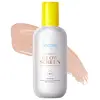What's inside
What's inside
 Key Ingredients
Key Ingredients

 Benefits
Benefits

 Concerns
Concerns

 Ingredients Side-by-side
Ingredients Side-by-side

Zinc Oxide 15.11%
Cosmetic ColorantWater
Skin ConditioningEthylhexyl Palmitate
EmollientCaprylic/Capric Triglyceride
MaskingPropanediol
SolventDimethicone
EmollientPolyglyceryl-3 Polyricinoleate
EmulsifyingSorbitan Isostearate
EmulsifyingPolyglyceryl-2 Dipolyhydroxystearate
Skin ConditioningFragaria Ananassa Seed Oil
AntioxidantPongamia Pinnata Seed Extract
Skin ConditioningClitoria Ternatea Flower Extract
Skin ConditioningPolyglyceryl-6 Polyricinoleate
EmulsifyingButylene Glycol
HumectantPolyhydroxystearic Acid
EmulsifyingPolysilicone-11
Inulin
Skin ConditioningMagnesium Sulfate
Triethoxycaprylylsilane
Sodium Phytate
Lecithin
EmollientIsopropyl Myristate
EmollientIsostearic Acid
CleansingGluconolactone
Skin ConditioningSodium Benzoate
MaskingCalcium Gluconate
HumectantIron Oxides
Titanium Dioxide
Cosmetic ColorantMica
Cosmetic ColorantZinc Oxide 15.11%, Water, Ethylhexyl Palmitate, Caprylic/Capric Triglyceride, Propanediol, Dimethicone, Polyglyceryl-3 Polyricinoleate, Sorbitan Isostearate, Polyglyceryl-2 Dipolyhydroxystearate, Fragaria Ananassa Seed Oil, Pongamia Pinnata Seed Extract, Clitoria Ternatea Flower Extract, Polyglyceryl-6 Polyricinoleate, Butylene Glycol, Polyhydroxystearic Acid, Polysilicone-11, Inulin, Magnesium Sulfate, Triethoxycaprylylsilane, Sodium Phytate, Lecithin, Isopropyl Myristate, Isostearic Acid, Gluconolactone, Sodium Benzoate, Calcium Gluconate, Iron Oxides, Titanium Dioxide, Mica
Water
Skin ConditioningDimethicone
EmollientPEG-10 Dimethicone
Skin ConditioningGlycerin
HumectantIsononyl Isononanoate
EmollientHdi/Trimethylol Hexyllactone Crosspolymer
Pentylene Glycol
Skin ConditioningCoco-Caprylate/Caprate
EmollientDicaprylyl Ether
EmollientSilica
AbrasiveSynthetic Fluorphlogopite
Cetyl PEG/PPG-10/1 Dimethicone
EmulsifyingPhenoxyethanol
PreservativeIsododecane
EmollientSodium Chloride
MaskingDimethicone/Vinyl Dimethicone Crosspolymer
Skin ConditioningMagnesium Sulfate
Ethylhexylglycerin
Skin ConditioningPropanediol
SolventDimethiconol
EmollientDisteardimonium Hectorite
StabilisingParfum
MaskingPropylene Carbonate
SolventTin Oxide
AbrasiveArtemisia Capillaris Flower Extract
Skin ConditioningSorbitol
HumectantTocopherol
Antioxidant1,2-Hexanediol
Skin ConditioningCaprylyl Glycol
EmollientXanthan Gum
EmulsifyingAscorbic Acid
AntioxidantColloidal Gold
AntimicrobialGlutathione
CI 77891
Cosmetic ColorantCI 77491
Cosmetic ColorantCI 77492
Cosmetic ColorantCI 77499
Cosmetic ColorantWater, Dimethicone, PEG-10 Dimethicone, Glycerin, Isononyl Isononanoate, Hdi/Trimethylol Hexyllactone Crosspolymer, Pentylene Glycol, Coco-Caprylate/Caprate, Dicaprylyl Ether, Silica, Synthetic Fluorphlogopite, Cetyl PEG/PPG-10/1 Dimethicone, Phenoxyethanol, Isododecane, Sodium Chloride, Dimethicone/Vinyl Dimethicone Crosspolymer, Magnesium Sulfate, Ethylhexylglycerin, Propanediol, Dimethiconol, Disteardimonium Hectorite, Parfum, Propylene Carbonate, Tin Oxide, Artemisia Capillaris Flower Extract, Sorbitol, Tocopherol, 1,2-Hexanediol, Caprylyl Glycol, Xanthan Gum, Ascorbic Acid, Colloidal Gold, Glutathione, CI 77891, CI 77491, CI 77492, CI 77499
Ingredients Explained
These ingredients are found in both products.
Ingredients higher up in an ingredient list are typically present in a larger amount.
Dimethicone is a type of synthetic silicone created from natural materials such as quartz.
What it does:
Dimethicone comes in different viscosities:
Depending on the viscosity, dimethicone has different properties.
Ingredients lists don't always show which type is used, so we recommend reaching out to the brand if you have questions about the viscosity.
This ingredient is unlikely to cause irritation because it does not get absorbed into skin. However, people with silicone allergies should be careful about using this ingredient.
Note: Dimethicone may contribute to pilling. This is because it is not oil or water soluble, so pilling may occur when layered with products. When mixed with heavy oils in a formula, the outcome is also quite greasy.
Learn more about DimethiconeMagnesium Sulfate is a salt. More specifically, it is an epsom salt, or the bath salt used to help relieve muscle aches.
Despite having ‘sulfate’ in the name, it isn’t a surfactant or cleansing agent like sodium lauryl sulfate. Unlike those sulfates, magnesium sulfate doesn’t have the same cleansing or foaming properties (it's simply a type of salt).
In cosmetics, Magnesium Sulfate is used to thicken a product or help dilute other solids. It is a non-reactive and non-irritating ingredient.
One study shows magnesium deficiency may lead to inflammation of the skin. Applying magnesium topically may help reduce inflammation.
You can find this ingredient in sea water or mineral deposits.
Learn more about Magnesium SulfatePropanediol is an all-star ingredient. It softens, hydrates, and smooths the skin.
It’s often used to:
Propanediol is not likely to cause sensitivity and considered safe to use. It is derived from corn or petroleum with a clear color and no scent.
Learn more about PropanediolWater. It's the most common cosmetic ingredient of all. You'll usually see it at the top of ingredient lists, meaning that it makes up the largest part of the product.
So why is it so popular? Water most often acts as a solvent - this means that it helps dissolve other ingredients into the formulation.
You'll also recognize water as that liquid we all need to stay alive. If you see this, drink a glass of water. Stay hydrated!
Learn more about Water